Affiliate marketing thrives as a powerful strategy in 2025. It empowers individuals and businesses to earn commissions by promoting products and services online.
The industry’s worth soars to $37.3 billion globally and is set to climb to $48 billion by 2027. In the U.S., it drives 16% of online orders, cementing its role in e-commerce.
This article dives deep into affiliate marketing statistics for 2025, covering market size, revenue, niches, trends, and more. It’s crafted for beginners and seasoned marketers eager to leverage affiliate marketing for profit.
We’ve also scoured platforms like Quora and Reddit to uncover fresh questions and insights users are discussing in 2025.
Table of Contents
ToggleWhy Affiliate Marketing Matters in 2026
Affiliate marketing offers a low-risk, high-reward way to earn income. You promote products, earn commissions, and avoid the hassle of inventory or customer service. It’s cost-effective for businesses too, delivering an average $12 return for every $1 spent.
With 81% of advertisers and 84% of publishers using it, affiliate marketing is a cornerstone of digital success. Whether you’re a blogger, influencer, or business owner, understanding the latest stats helps you tap into this growing industry.
Key Affiliate Marketing Statistics for 2026
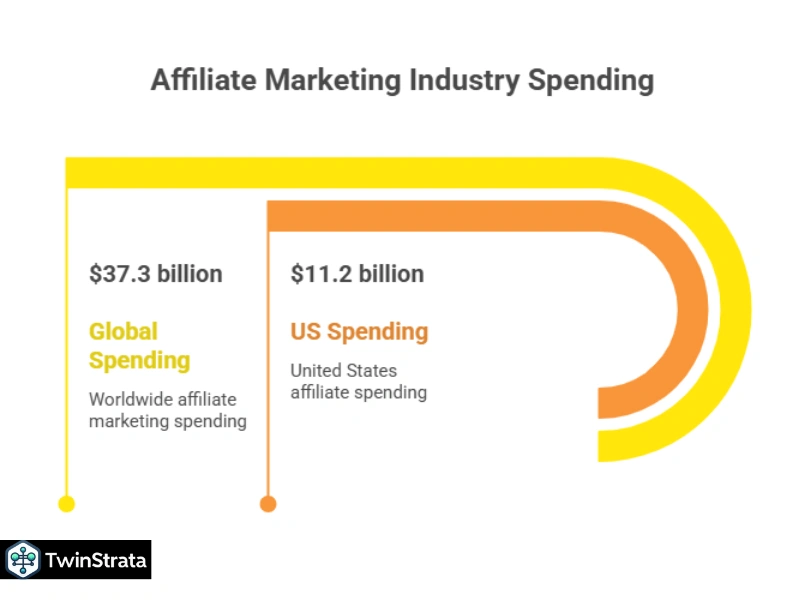
Here’s a snapshot of the most compelling stats to guide your affiliate marketing journey:
- The global affiliate marketing industry reaches $37.3 billion in 2025.
- U.S. affiliate marketing spending surpasses $11.2 billion, up from $9.1 billion in 2023.
- Affiliate marketing drives 16% of online orders in the U.S. and Canada.
- 80% of brands run affiliate programs to boost sales and awareness.
- 65% of affiliate marketers use blogs to generate traffic and commissions.
- Businesses earn an average 12:1 return on ad spend (ROAS) through affiliate marketing.
- Amazon Associates leads with a 48.23% market share among affiliate networks.
Affiliate Marketing Market Size and Growth
The affiliate marketing industry grows at a staggering pace. From $20.3 billion in 2021, it hits $37.3 billion in 2025 and is projected to reach $48 billion by 2027.
The annual growth rate stands at 14.7% in 2025, slowing slightly to 14.3% in 2026. This growth reflects the increasing trust in affiliate marketing as a reliable revenue stream.
Here’s a detailed look at the market size over the years:
| Year | Global Market Size (USD Billion) |
| 2027* | $48.0 billion |
| 2026* | $42.6 billion |
| 2025* | $37.3 billion |
| 2024* | $32.3 billion |
| 2023 | $27.8 billion |
| 2022 | $23.6 billion |
| 2021 | $20.3 billion |
| 2020 | $17.2 billion |
| 2019 | $16.6 billion |
| 2018 | $15.3 billion |
| 2017 | $14.1 billion |
| 2016 | $13.0 billion |
Source: Statista
Affiliate Marketing Spending Trends
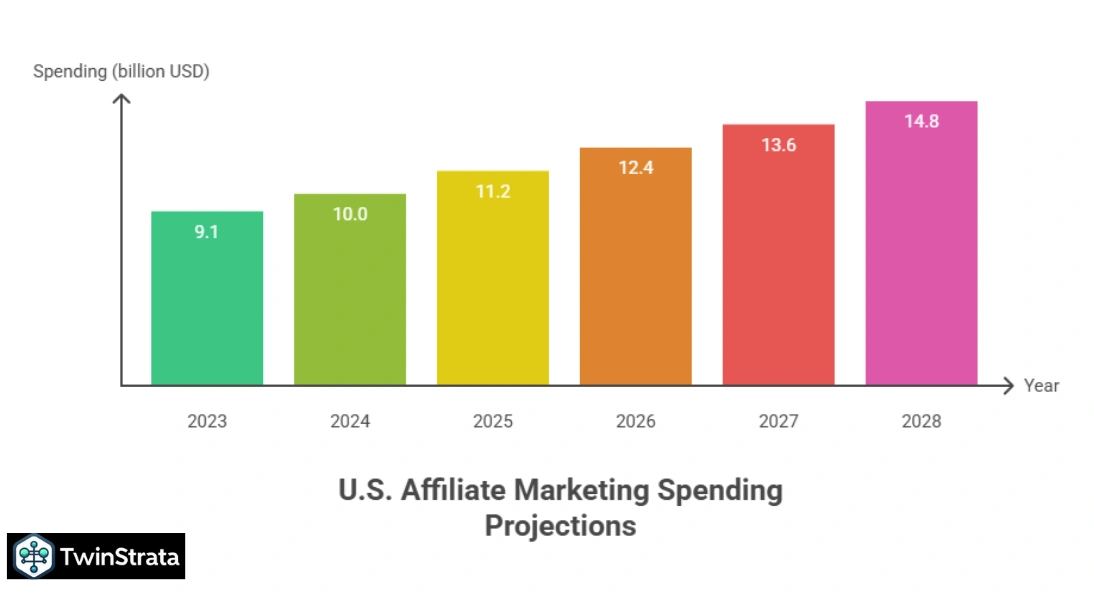
Businesses invest heavily in affiliate marketing. Global spending hits $15.7 billion in 2025, with the U.S. alone contributing $11.2 billion. This marks a significant jump from $9.1 billion in 2023.
By 2028, U.S. spending is expected to reach $14.8 billion. These numbers highlight the confidence brands have in affiliate marketing’s ability to drive sales.
Here’s a breakdown of U.S. affiliate marketing spending:
| Year | Spending (USD Billion) |
| 2028* | $14.8 billion |
| 2027* | $13.6 billion |
| 2026* | $12.4 billion |
| 2025* | $11.2 billion |
| 2024* | $10.0 billion |
| 2023 | $9.1 billion |
Source: eMarketer.
- 33% of marketers plan significant increases in their affiliate budgets in 2025.
- 62% of marketers intend to boost spending over the next year.
- 6 in 10 brands increase affiliate commission budgets to attract top publishers.
- Also read about: AffiliatePages Review
Affiliate Marketing Revenue and Earning Potential
Affiliate marketing offers diverse earning opportunities. Beginners earn $0 to $1,000 per month, while top-tier “super affiliates” rake in over $100,000 monthly. On average, affiliate marketers earn $8,038 per month, and 9% of marketers make over $50,000 annually. Income varies by niche, experience, and strategy.
Here’s a breakdown of monthly earnings by career stage:
| Career Stage | Monthly Income |
| Beginner | $0 to $1,000 |
| Intermediate | $1,000 to $10,000 |
| Advanced | $10,000 to $100,000 |
| Super Affiliate | Over $100,000 |
Top-Performing Niches
Certain niches yield higher earnings. Education and travel lead the pack, with average monthly incomes of $15,551 and $13,847, respectively. Beauty, finance, and technology also offer lucrative opportunities.
Here’s a table of average monthly incomes by niche:
| Niche | Average Monthly Income |
| Education and eLearning | $15,551 |
| Travel | $13,847 |
| Beauty and Skincare | $12,475 |
| Finance | $9,296 |
| Technology | $7,418 |
| Digital Marketing | $7,217 |
| Health & Fitness | $7,194 |
| E-commerce | $5,967 |
| Home & Garden | $5,095 |
| Sports & Outdoors | $4,849 |
| Entertainment | $4,416 |
| Food & Nutrition | $3,015 |
| Fashion | $2,049 |
| Personal Development | $1,566 |
| Parenting & Family | $1,145 |
| Arts & Crafts | $1,041 |
| Pets & Animals | $920 |
| Sustainability & Environment | $555 |
Affiliate Marketing Usage and Performance
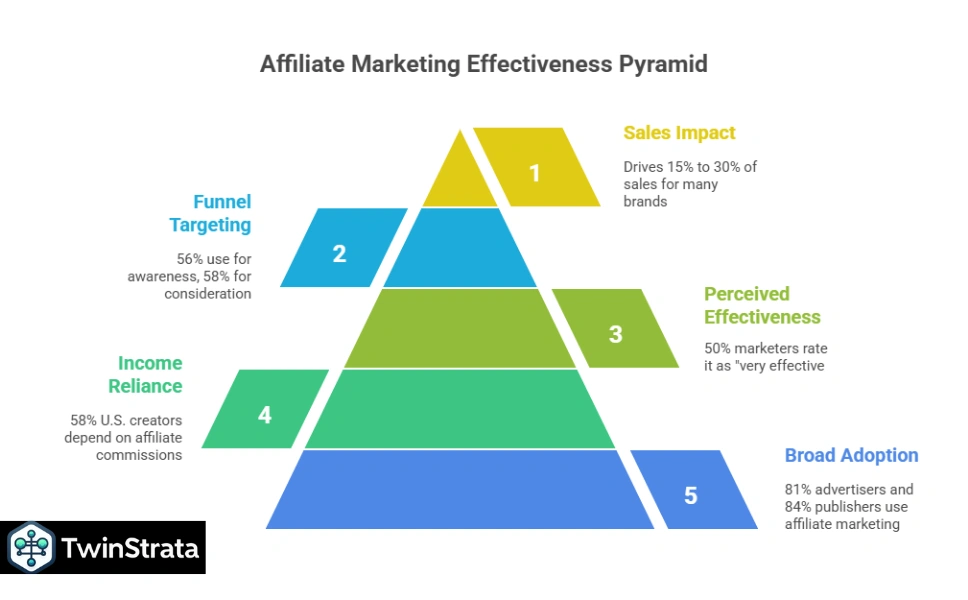
Affiliate marketing’s effectiveness lies in its versatility. It’s used for brand awareness, lead generation, and sales. Here are key stats:
- 81% of advertisers and 84% of publishers leverage affiliate marketing.
- 58% of U.S. content creators rely on affiliate commissions as a primary income source.
- 50% of marketers rate affiliate marketing as “very effective” for business goals.
- 56% of marketers use it for upper-funnel awareness, while 58% target mid-funnel consideration.
- Affiliate programs drive 15% to 30% of sales for many brands.
Revenue Contribution
Affiliate marketing accounts for significant revenue shares:
| Revenue Share | Brands (%) | Publishers (%) |
| 1-5% | 19.6% | 17% |
| 6-10% | 21.7% | 8% |
| 11-20% | 23.9% | 6% |
| 21-30% | 13.0% | 3% |
| 31-50% | 10.9% | 13% |
| Above 50% | 0.0% | 50% |
| Don’t Know | 10.9% | 3% |
Affiliate Networks and Platforms
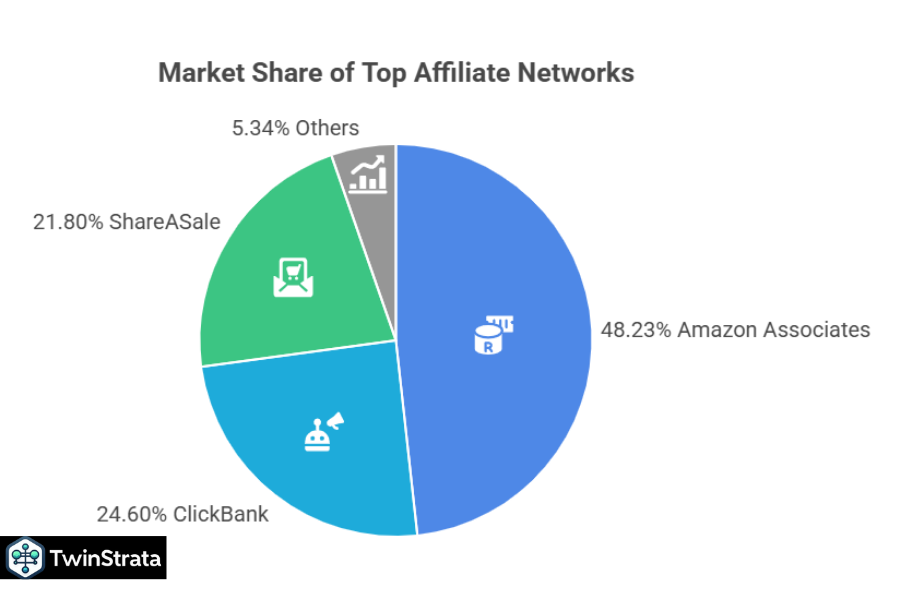
Affiliate networks connect brands with publishers. Amazon Associates dominates with a 48.23% market share and 900,000 affiliates. Other major players include ShareASale, Awin, and ClickBank.
Here’s a look at the top affiliate networks by usage:
| Affiliate Network | Percentage of Marketers Using | Number of Affiliates |
| Amazon Associates | 48.23% | 900,000 |
| ShareASale | 21.8% | 700,000 |
| ClickBank | 24.6% | 100,000 |
| CJ Affiliate | 20.5% | Not specified |
| Awin | 11.7% | 225,000 |
| Rakuten | 7.12% | 150,000 |
Source: Statista.
- TikTok Shop, launched in 2023, already boasts 100,000 creators in its affiliate program.
- 24.46% of marketers find affiliate programs directly on merchants’ websites.
- 19.21% use search engines like Google to locate programs.
Affiliate Marketing Demographics
Who are affiliate marketers?
Here’s a breakdown:
- 32% are aged 35–44.
- 54% are male, 43% are female, and 3% identify as other.
- 57% are based in the U.S., 10% in Canada, and 2% in India.
- 54.28% work from home, while 19.21% work from offices.
- 34% are single, and 55% are married.
Payment preferences also vary:
- 50% prefer direct payment options.
- 19.16% use PayPal, while 69% opt for Bitcoin (BTC).
Social Media and Affiliate Marketing
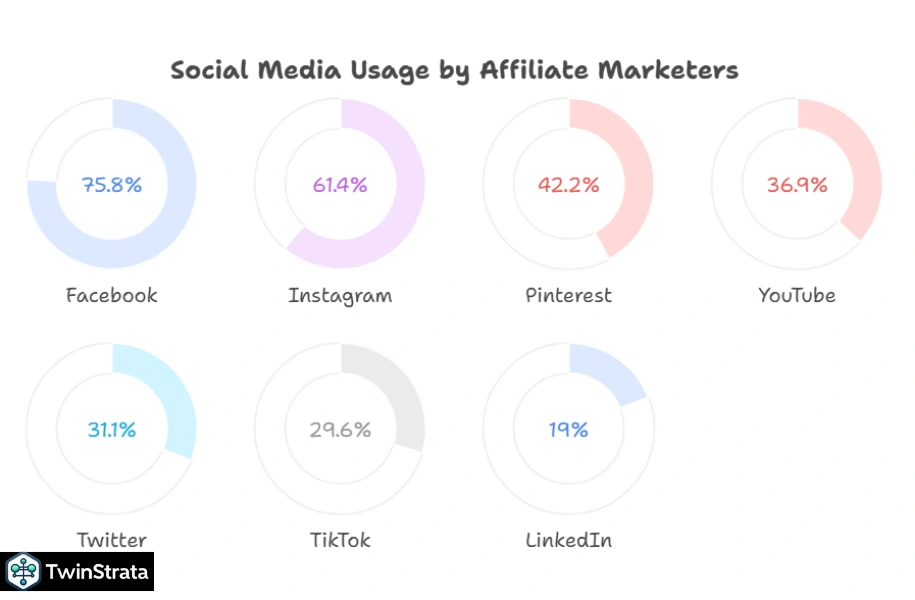
Social media is a powerhouse for affiliate marketers. 65% use platforms to connect with audiences. Facebook leads with 75.8% of marketers, followed by Instagram at 61.4%.
Here’s a table of preferred social media platforms:
| Platform | Percentage of Marketers Using |
| 75.8% | |
| 61.4% | |
| 42.2% | |
| YouTube | 36.9% |
| 31.1% | |
| TikTok | 29.6% |
| 19% |
Source: Authority Hacker.
- 13.8% of Instagram affiliates focus on the lifestyle niche, followed by travel, beauty, and fashion.
- Mobile devices account for 50% of affiliate traffic, emphasizing the need for mobile-optimized content.
Affiliate Marketing Fraud Concerns
Fraud remains a challenge. 40% of affiliate traffic is fraudulent, costing businesses $1.5 billion in 2025. This is down from $3.4 billion in 2022, but AI-driven fraud is a growing concern.
- 63% of marketers worry about fraud.
- 30.9% have experienced fraud in the past.
- Fraudulent clicks accounted for 17% of affiliate traffic in 2022.
Emerging Trends in Affiliate Marketing for 2026
Affiliate marketing evolves rapidly. Here are the top trends shaping 2025, including insights from Quora and Reddit discussions:
1. AI-Powered Personalization
AI transforms affiliate marketing. 72% of smartphone users rely on voice assistants daily, and 43% of smart speaker owners use voice search for shopping.
Marketers use AI to automate lead generation, personalize campaigns, and optimize ad targeting. On Reddit, users ask, “How can AI tools like chatbots improve affiliate conversions?” The answer lies in AI’s ability to analyze user behavior and deliver tailored recommendations.
2. Video and Podcast Content
Video and podcasts gain traction. 58% of newly added publishers on Awin in 2023 were influencers creating video content. Long-tail keywords in video descriptions boost SEO. Quora users frequently ask, “Are YouTube affiliate links still effective in 2025?” The consensus is yes, especially for niches like tech and beauty, where tutorials drive clicks.
3. Metaverse Opportunities
The metaverse opens new doors. As virtual worlds grow, marketers explore affiliate programs for digital goods and experiences. Reddit threads highlight questions like, “Can you promote affiliate links in VR platforms?” Early adopters are experimenting with virtual storefronts and immersive ads.
4. Co-Partnerships
Collaborations between affiliates increase. Co-partnerships amplify reach and reduce campaign risks. On Quora, users ask, “How do I find affiliate partners for joint promotions?” Successful partnerships often start on social platforms or affiliate networks like Impact.
5. Secondhand Market Growth
The secondhand market booms, with a projected value of $350 billion by 2027. Affiliate programs for thrift platforms like Poshmark and ThredUp gain popularity. Reddit users note, “Secondhand fashion affiliate programs are underserved—huge potential for 2025.”
6. Cross-Device Tracking
Consumers use multiple devices, making cross-device tracking essential. 47% of visitors expect websites to load in under 2 seconds, and a 1-second delay can cut sales by 7%. Marketers must optimize for seamless experiences across devices.
How to Succeed in Affiliate Marketing in 2026
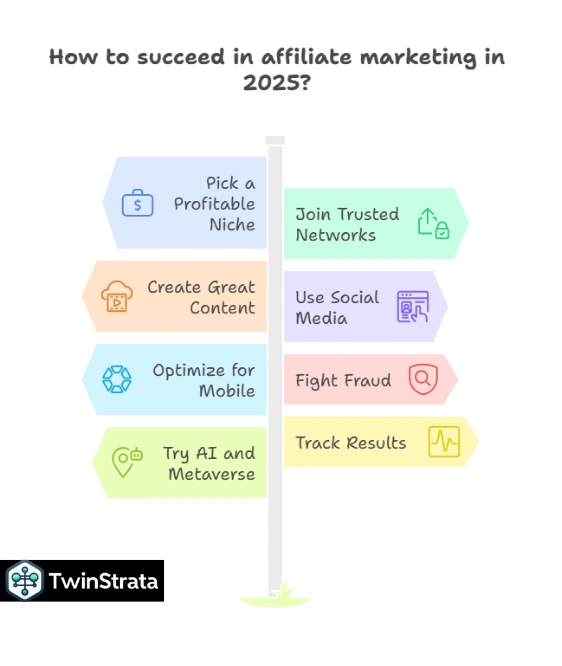
Ready to dive into affiliate marketing? Here’s a step-by-step guide based on 2025 trends and user questions from Quora and Reddit:
1. Choose a Profitable Niche:
Focus on high-paying niches like education ($15,551/month) or travel ($13,847/month). Reddit users suggest starting with a niche you’re passionate about to stay motivated.
2. Join Reputable Networks:
Start with Amazon Associates, ShareASale, or ClickBank. Quora users recommend diversifying across multiple networks to maximize earnings.
3. Create Quality Content:
Blogs drive 65% of affiliate traffic, while videos and podcasts gain traction. Optimize for SEO with long-tail keywords, as 80% of marketers rely on organic search. Use the best AI SEO tools to enhance your strategy and boost rankings.
4. Leverage Social Media:
Use Instagram and YouTube for visual niches like beauty or travel. 75.8% of marketers use Facebook for broad reach. TikTok’s affiliate program is a hot topic on Reddit for short-form content.
5. Optimize for Mobile:
With 50% of traffic from mobile devices, ensure your website is responsive. A slow site loses 40% of visitors if it takes over 3 seconds to load.
6. Combat Fraud:
Use fraud detection tools to protect your campaigns. Reddit users warn about fake clicks draining budgets, especially in high-traffic niches.
7. Experiment with AI and Metaverse:
Test AI tools for personalization and explore metaverse platforms for innovative promotions. Quora users ask, “Is AI worth the investment for small affiliates?” For beginners, free AI tools can provide a competitive edge.
8. Track Performance:
Use analytics to monitor cross-device engagement. Tools like Semrush help with keyword research and site audits, as noted by Reddit marketers.
Challenges and Opportunities
Challenges
- High Failure Rate: 95% of affiliate marketers quit due to slow results. Patience and strategy are key.
- Fraud Risks: Fraud costs billions annually. Invest in tools to detect suspicious traffic.
- Competition: Top 10% of marketers earn 90% of revenues. Stand out with unique content.
Opportunities
- Growing Market: With a $37.3 billion market in 2025, there’s room for new players.
- Diverse Niches: From secondhand goods to digital courses, affiliates can tap into varied markets.
- Global Reach: The U.S. holds a 39% share, but markets like India (2%) are growing.
FAQs About Affiliate Marketing Statistics
1. Is affiliate marketing still profitable in 2025?
Yes! With a 12:1 ROAS and a growing market, affiliate marketing remains lucrative. Success depends on niche selection and consistent effort.
2. What’s the best platform for beginners?
Amazon Associates is beginner-friendly due to its vast product range. Reddit users also recommend ShareASale for diverse programs.
3. How do I avoid affiliate marketing scams?
Research programs thoroughly, avoid “get-rich-quick” schemes, and use fraud detection tools. Quora users emphasize sticking to reputable networks.
4. Can I start affiliate marketing with no money?
Yes, start with free platforms like blogs or social media. Reddit users suggest free SEO tools to drive traffic without upfront costs.
5. How important is SEO in 2025?
Critical—80% of marketers rely on SEO. Long-tail keywords and mobile optimization are essential for visibility.
Also Read:
- Email Marketing Statistics
- Video Marketing Statistics
- Digital Marketing Statistics
- CRM Statistics
- Social Media Statistics
Conclusion: Why Affiliate Marketing Is Your 2026 Opportunity
Affiliate marketing shines as a dynamic, profitable industry in 2025. With a market size of $37.3 billion and a projected growth to $48 billion by 2027, it’s a goldmine for those willing to invest time and effort.
From high-earning niches like education and travel to emerging trends like AI and the metaverse, opportunities abound. Whether you’re a beginner or a seasoned marketer, leverage these insights to build a thriving affiliate business.
Start small, optimize for mobile, and stay ahead with trends like video content and co-partnerships. The future is bright—jump in now!
